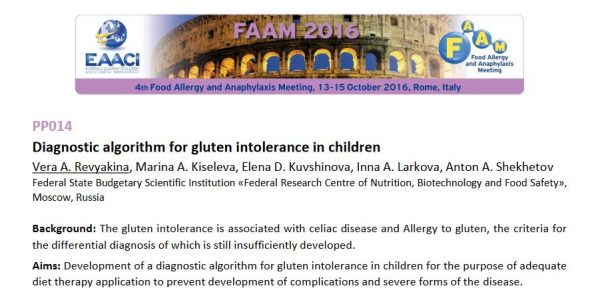Vera A. Revyakina, Marina A. Kiseleva, Elena D. Kuvshinova, Inna A. Larkova, Anton A. Shekhetov
Federal State Budgetary Scientific Institution «Federal Research Centre of Nutrition, Biotechnology and Food Safety», Moscow, Russia
Background: The gluten intolerance is associated with celiac disease and Allergy to gluten, the criteria for the differential diagnosis of which is still insufficiently developed.
Aims: Development of a diagnostic algorithm for gluten intolerance in children for the purpose of adequate diet therapy application to prevent development of complications and severe forms of the disease.
Methods: Under supervision there were 42 children with chronic diarrhea and symptoms of impaired intestinal absorption. The diagnostic algorithm consisted of the following stages. The first stage – the detection of the risk groups for gluten enteropathy. These include: 1) immediate relatives of patients with celiac disease; 2) close relatives with allergic diseases; 3) children with gastrointestinal symptoms resistant to standard therapy; 4) children, lagging in physical development and with symptoms of impaired intestinal absorption; 5) patients with dermatitis herpetiformis and diseases that can be associated with celiac disease. At the second stage children included in the risk group were subjected to screening diagnostics.We used the BIOCARD TM Celiac Test (Finland), which allows to determine antibodies to tissue transglutaminase (IgA). Patients with a confirmed diagnosis of celiac disease and positive (BIOCARD TM Celiac Test) test was not included in further examination. The third stage of gluten intolerance diagnostics was in — depth examination of children with gastrointestinal and skin manifestations of Allergy, including anamnesis and clinical symptoms, determination of total IgE, IgG, IgA, IgM and specific IgG and IgE antibodies in the blood serum.
Results and Discussion: Three groups of patients were identified. The first group consisted of 23 children with positive allergen — specific IgE antibodies to gluten and wheat and to cow’s milk protein in serum. In 10children from the second group IgE and IgG antibodies to gluten and wheat serum were identified at the same time. They had gastrointestinal symptoms within a few hours after eating a certain amount of foodscontaining gluten (individual for each child). The third group of patients included 9 children with IgG antibodies to gluten and wheat serum. Clinically they mainly had skin rashes.
Conclusion: The staged diagnostic algorithm for gluten intolerance in children allows to determine the mechanism of gluten intolerance and toprescribe required elimination diet and treatment aimed at prevention of serious complications.
